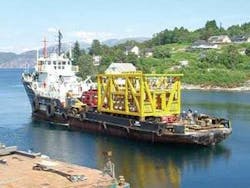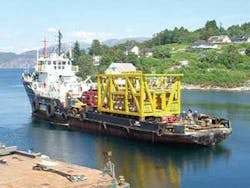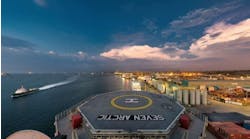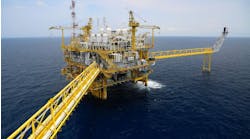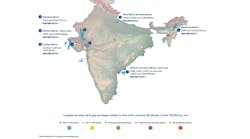The subsea manifold for Oilexco’s Brenda project in the UK North Sea is a novel solution for small field developments. Within the manifold system, designer/fabricator Framo Engineering includes production and test facilities, a lift-gas system, a multiphase flow-meter, and a multiphase booster pump and controls, not only for these facilities but also for Brenda’s subsea trees and additional offset field tie-ins.
Despite its multifunctional nature, the manifold is a compact structure weighing 120 metric tons and measuring 10 m x 6 m x 5 m. The key to reducing its size and weight compared with a conventional manifold solution is the multiport selector manifold (MSM) developed by Framo, says sales director Jon Sværen.
The MSM, also referred to as a spider manifold, consists of a housing with up to eight production inlets to which individual wells are connected. It also has a main production outlet and a test outlet. Within the housing is a selector - the only moving part - which can be connected to any of the production inlets. While production continues through the other inlets, the flow from the inlet to which the selector is connected is diverted through a multiphase meter test facility before it recombines with the flow from the other wells.
While a conventional arrangement requires two hydraulic and two manual isolation valves for each well to divert production from the main to the test header, the MSM needs only one manual double block and bleed isolation valve for each inlet. For an eight-well manifold, this saves 24 valves.
The first MSM was supplied last year to Kerr-McGee’s Gryphon Field, also in the UK sector. Compared with proposals for conventional manifolds, which would have weighed around 160 metric tons, Framo’s MSM proposal amounted to a mere 65 metric tons. This allowed use of a lighter class of installation vessel, with significant cost savings, Sværen points out.
Brenda’s manifold was developed in cooperation with Oilexco, and provides solutions to a number of challenges faced by the project. One of these is the low reservoir pressure. With up to 20-km step-outs and a low gas-to-oil ratio of the hydrocarbons, the production stream needs to be given a boost, especially as water cut increases and gas-lift becomes scarce. Instead of the electric submersible pumps which the operator was considering, Framo proposed an alternative - multiphase boosting combined with gas-lift to start the wells.
“Our system delivers nearly as much production as ESPs, but with a much lower risk,” says Vidar Kristiansen, Framo’s project manager for the Brenda delivery. While ESPs give high drawdown, they have reliability problems and require an expensive rig to retrieve them for maintenance or repair. In contrast, the combination of multiphase pumping and gas-lift gives redundancy, low-cost maintenance, and easy control. It also means standard trees can be used, and interfaces between completions, wells, and controls are simplified.
Controls are provided by a fiber-optics based communications system jointly developed by Framo and Schlumberger. The fiber optics provide a high-capacity system, with 100 MB bandwidth. This means a single control system can control not only a large number of valves and sensors for each pod, but also the pump, multiphase meter, and tree controls. Again, this provides a simpler solution compared with the alternative of a separate control system for the trees, with separate pods and a separate umbilical. The control pods are mounted on the manifold.
Another advantage of the fiber-optic technology is that it is noise immune - unlike previous control communication systems, it can be packed in the same umbilical as the high-voltage power cable.
The fact that the engineering of all the interfaces is performed by Framo is a further benefit, saving the customer from investing in the resources needed to perform this task.
The manifold system is very maintenance-friendly, Kristiansen says. All active parts - the pump, meter, and control pods - are retrievable separately using ROVs, so that intervention can be carried out by a light vessel deploying simple ROV-operated tools. The system also provides flexibility to factor in other tie-backs. Nicol, 10 km away, will be tied back to the manifold - this scope was added after the Brenda project got under way, Sværen says.
Oilexco plans initially to drill three subsea wells on Brenda and one on Nicol. Up to two more may be drilled later on Brenda, and another on Nicol. One production inlet is reserved for a second possible satellite tieback. The manifold will be tied back to the Balmoral platform by a 10-in. production pipeline and 6-in. gas-lift line.
System integration testing was scheduled to start around mid-year. The manifold is due to be installed in September and hooked up in October. Installation will be done remotely, but divers will carry out the hook-up. The manifold will be installed inside a gravity-based protection structure weighing 85 metric tons. First oil is scheduled for November.
The multiphase pump is a standard Framo helico-axial unit. The company has 17 such subsea pumps installed around the world, with a total of more than 600,000 hours of operation.
This summer Framo also will deliver a subsea raw seawater injection system - the world’s first - to CNR’s Columba E field in the UK sector. The pump will provide 55,000 b/d water injection capacity.
